Trans Mongolia
> The route
In fact there are three routes that all three are called Trans Siberia Express. But there is a difference.
- The real Trans Siberia trip runs from Moscow, via Irkutsk to Wladiwostok.
- The Trans Mongolia Express also starts in Moscow, but runs via Irkutsk to Mongolia and finally to Beijing.
- And the Trans Manchuria Express runs from Moscow to Irkutsk and the Chinese Manchuria to Beijing.
-
We chose to travel by Trans Mongolia Express, because we really wanted to see parts of Russia, but we definately wanted to visit Mongolia as well. We booked the trip at Tiara Tours and were satisfied with what we got: good service and a wonderful trip! This is the route we did by train (a total of 6 days in the train if you don't make any stops somewhere):
But lucky for us we planned a few stops. We were 4 days in Moscow, 2 days in Suzdal, more than a week in Mongolia and a week in Beijing as well.
> Preparation
To prepare for the trip we collected all different types of information. We wanted to know more about life in the train, but of course also about the three countries we were looking forward to visit: Russia, Mongolia and China. This is how we got our info:
- books (check below: Handy books and useful websites)
- websites from organizations and other travellers (check below: Handy books and useful websites)
- the movie: The story of the weeping camel, about a nomad family in Mongolia
- information meeting Tiara Tours
-
> Vaccinations
When you ask any of the consultants for their oppinion about recommended vaccinations for this trip you'll never get the same answer. We went to our doctor for advise and to the chemist, but we also checked the website of lcr (Dutch CDC). After some discussions we decided to get the Hepatitus A- and DTP- (tetanus-diphtheria and measles) vaccinations, about 3 months before the start of the trip.> Visa
For all three of the countries you can visit by Trans Mongolia Express a visa is necessary. Most of the time the visa can be arranged by the travel agency where you book your trip. Of course you can also arrange them yourself, but make sure you do it on time, as it takes a while before you can collect your Russian visa. Tiaratours arranged our own visa.These are the costs of the visa:
- Russia: € 60,-
- Mongolia: € 38,-
- China: € 42,-
-
These are the costs if you arrange them yourself, when you ask the travel agency to help they will ask for a fee as well.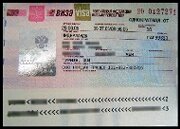
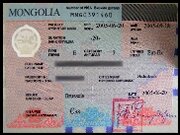
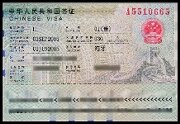
> Packinglist
On this journey we carried our luggage in a trolley and a backpack, what turned-out to be a good combination: the trolley was very useful on the railway stations and it fitted exactly into the luggage space under the seats. The dimensions of your suitcase can't be more than 70Lx40Wx30H, otherwise it won't fit into the storage in the train. During our excursions to Terelj and Kharkorin in Mongolia, we left our suitcase in the luggageroom of the hotel in Ulan Bator and only brought the backback. We did not see ourselves carrying a suitcase through the steppes.The following things were on our packinglist:
- (Disposable-) clothing (Old clothes saved for a year to leave behind when dirty, so our suitcase would be empty when arriving in Beijing. We completely filled it up with new clothing, cd's and souvenirs to take back home after a couple of days of shopping.)
- toiletrequisites, including soap leaves
- plastic plates, cutlery and plastic cups
- 2 towels
- Inflatable pillows, sheetcovers and pillow covers(also old)
- camera and accessories
- World plug adapter
- gameboy, games, discman and mp3 cd's
- mueslibars, crackers, biscuits, peanuts, instant soup and tea
- toiletpaper and paper toiletseats!!
- wet tissues !!
- travelguides, Russian, Mongolian and Chinese language guides and the booklet Point-it with loooot's of pictures.
- dollars, euro's and cash card
- hipbag
- alarm clock
- travel- and insurrance documents
- Medical kit !! (with elastoplast, bandages, ORS rehydration salt !!, norit !!, paracetamol, DEET, azaron and vitamine pills)
- little presents: sweets for the kids, balloons, postcards of the Netherlands, pens en books
-
> Money
You don't need to bring creditcards or travelerscheques. We brought about 300 Dollars and 100 Euros and our cash card. Eventually we didn't use the Euros at all and we only needed the Dollars in Mongolia (and 50 dollar is a lot of money there). In Moscow and in Beijing there were plenty ATM's where we could get some money in the local currency.
In the train you can use Russian Rubels untill the Mongolian border. We had some Rubels left when we reached the border, but of course there were more Mongolians trying to make some money out of changing our last Rubels into Tugrük. They gave us a good rate of exchange, but it still was possible to negotiate. At the Chinese border there is no possibility to change money, so make sure you spent everything. For the entire journey in the train we used about € 100,- for 2 persons for food. A few times we ate in the restaurant on board, but there was plenty of food to buy on the platforms as well, and that food was really cheap. But the place where we became even more happy was Beijing: cd's only cost € 1,50 and t-shirts from € 1,- to € 5,-, just to name some things.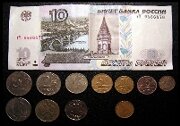
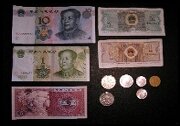
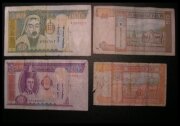
> Security
During the entire trip we didn't feel unsafe once, not even in the big cities or on the platforms. In Moscow and Beijing there were plenty of people in uniform watching everything, but everything was quiet all the time. We didn't go out much after it got dark, so we don't know what happens then, but during the day everything was fine. There were a few books that wrote about pickpockets on the station in Ulaanbaator, but we just waited for the most people to get off the train and we could get off too and look for our guide safely.> The train
Opposite of what some people say it was a great experience for us to travel second class and to share a compartment with Mongolian people. Officially there should sleep one Mongolian lady in our compartment (but that was just how it should be. The bed of this lady ended up to be a fully packed storehouse, only the last night there slept 2 instead of one lady on top of some boxes.) So we watched the selling (and hiding!) of the merchandise from very close. We feel like we really would have missed something when we'd booked a first class ticket and slept in a compartment for 2.
In the compartment is room for four persons, with two pairs of beds above each other. The upper beds are slightly shorter than the lower and are warmer during the night. The beds are attached to the wall with two chains, one on the head and one on the foot. Some people didn't like the upper beds, but I slept well on them. The luggage space under the lower beds and above the hallway (for the two upper beds) are large enough for your luggage, if you don't give away to much space to the Mongolians, like our Norwegian colleague-European Espen almost did.
During the ride from Vladimir to Ulan Bator, the train was kept perfectly clean by the Mongolian provodniks. Their Chinese collegues on the Ulan Bator-Beijing route were a little less clean, but then this journey only took one day. In every car there is a Samowar, were you can always get hot water. There are also two toilets with a little sink, where you can clean yourself or brush your teeth. Be aware: starting 15 minutes before 'till 15 minutes after a stop, the toilets are locked. This isn't a problem at the stations, but at the border it can be. You'll be standing still at the Russian-Mongolian border for 5 to 6 hours (if you're lucky). It's a little shorter at the Mongolian-Chinese bordercrossing.> Handy books and useful websites
We used the following books and websites before our trip started: - Eyewitness Travelguide from Moscow: very clear as usual and with handy pictures and descriptions.
- Bradt Travel Guide Mongolia: We didn't use this one ourselves, but some one we met in Ulaanbaator suggested this guide. Because it's hard to find a good travel guide about Mongolia it might be a good suggestion. We still want to buy it ourselves to read some backgroundinformation and check some things.
- Te gast in Mongolië: Dutch book with backgroundinfo and travel stories
- Steppeland by Tjalling Halbertsma: Fantastic book written by the adviser of the Mongolian president who has travelled a lot in Mongolia.
- Lonely Planet Mongolian Phrasebook: this book made it possible for us to communicate with the other Mongolian travellers.
- The Rough Guide to Beijing: loads of info and useful tips, with handy maps included.
- Lonely planet Mandarin-Chinese: we didn't use this one very much, because many signs in Beijing are also in English and we did all the sightseeing just with the 2 of us.
- Sporen van Moskou naar Beijing by Fons Hannes: Traveljournal from a Belgian traveller.
- Point it Traveller's language kit: A booklet with looooots of pictures, very useful when you don't know how to say something.
- Het lcr (Dutch CDC) for advise about vaccinations and other health issues for travellers.
- Mongolië-reizen.pagina.nl for travelogues of other (Dutch) people doing the Trans-Siberian/Trans-Mongolian and for travelinfo.
- transsiberie-express.pagina.nl Dutch website
- mongolie.pagina.nl Dutch website
-
Also, we surfed a lot on the internet searching for information. We can't show you all the addresses here, but it's a start. Enjoy surfing!
> More info
Want to know more? Check our Travel Journal and Photos about the Trans Mongolia Express.